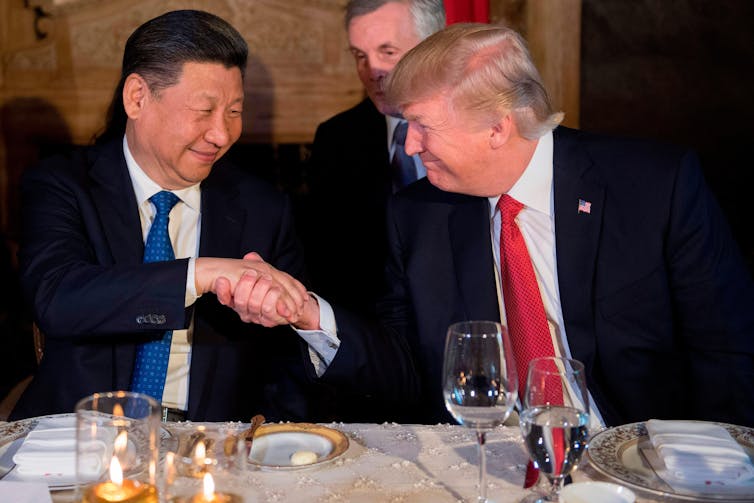The US president, Joe Biden, has announced new tariffs on imports of electric vehicles, solar equipment and batteries from China. The move comes a month after he called for higher tariffs on Chinese steel and aluminium products, and said that his administration would investigate Chinese shipbuilding.
Tariffs will increase from 25% to 100% on electric vehicles, from 7.5% to 25% on lithium batteries, and from 25% to 50% on solar cells. Tariff rates on certain steel and aluminium products will also more than triple to 25%, up from 7.5% or less.
With the 2024 US presidential election drawing closer, both Biden and the Republican presidential candidate, Donald Trump, are keen to convince voters they are tough on China. In an interview with Time magazine in April, Trump suggested that tariffs of more than 60% on Chinese goods were part of his plan, should he be elected.
They argue the tariffs will stop cheap electric vehicles and other products flooding the US market. Following the announcement of the tariff hikes, the US treasury secretary, Janet Yellen, insisted the tariffs would protect American jobs.
However, the existing tariffs on imports from China are already prohibitive, and have had a significant effect on sales of such products in the US. So, raising tariffs even further will probably have very little impact on US consumption.
What it may mean is a full-blown trade war, which could hurt American consumers. China immediately said it was opposed to the hikes, and has vowed to take “resolute” retaliatory measures.

The decision to raise tariffs is a response to the Chinese government’s policy of subsidising Chinese products, such as electric vehicles. These subsidies ensure Chinese companies do not have to turn a profit, which according to the Biden administration gives them an unfair advantage in global trade.
This sounds like a fairly simple rationale – but there are a few complexities. First, the US and many other western countries use the same type of policies. In the US, the Inflation Reduction Act, a subsidy programme that aims to promote investment in green technologies, includes the clean vehicle tax credit for purchases of certain electric vehicles.
Measuring subsidies can be difficult. But a recent article by the Kiel Institute, an economic research institute and thinktank, suggested Chinese subsidies are much higher than those of countries such as the US.
So, the argument for levying new tariffs is not that China uses subsidies, but that they are much higher than those used by the US government. That isn’t quite such a simple message for the electorate, and the numbers could be debated.
Second, there are World Trade Organization (WTO) rules to deal with such matters. In March, China requested WTO dispute consultations on the US clean vehicle tax credits, arguing that the policy discriminates against Chinese goods.
A request for consultation is the first step in a dispute settlement process, and we are likely to see a new request regarding the latest US tariff increases. However, the WTO’s appellate body, which hears cases brought by WTO members, is in crisis. Since 2017, the US has been blocking the appointment of new judges to the appellate body, due to concerns around US sovereignty and the WTO’s judicial overreach.
In doing so, it has limited the ability of the WTO to deal with these types of dispute. Under normal circumstances, the US would be expected to take its complaint about Chinese subsidies to the WTO, just like China has done. Bypassing the WTO in such matters is only limiting the role and effectiveness of the organisation, risking damaging cycles of tariffs and retaliation.
Third, although higher tariffs are unlikely to reduce the volume of US imports from China significantly in the short term, they may force companies selling to the US market to adjust their supply chains in the future. To avoid these steep tariffs, manufacturers may be incentivised to shift production towards US allies such as Mexico.
There’s a new trade war brewing
Given the WTO is unlikely to be able to resolve this dispute, the tariff hikes may well spark a trade war involving rounds of retaliatory tariffs by both the US and China.
The US raised tariffs on imports from China substantially during the Trump administration, launching a trade war between the two countries in 2018. Careful observers will note that the tariff increases seen in this period were never reduced to their pre-trade war levels.
In 2020, while Trump was still president, the US and China signed a deal to ease the trade war. But the deal didn’t include tariff reduction commitments, and instead established new US tariffs on imports from China for the foreseeable future.

The fact that tariff rates are already high is an issue for a US administration wishing to appear tough on China. One option is to follow the latest policy announcement and raise already high tariffs further. This is unlikely to change the amount of Chinese goods that US consumers buy, but it will create headlines as Biden looks to convince voters he is doing all he can to protect American producers.
Another option, albeit a less appealing one, would be to raise the proportion of imported goods that are subject to these high tariffs. The downside of this option is that it will start to hurt domestic consumers. The goods currently exempt from these high tariffs tend to be items for which Americans can’t find easy substitutes, such as smartphones and game consoles.
These fresh tariffs probably won’t have any significant effects in the short term. But in the future, global supply chains will adjust, and we might expect to see manufacturing shift from China to countries like Mexico.

